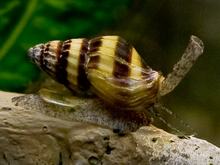Anentome helena, common name assassin snail or bumblebee snail, is a species of freshwater snail with an operculum, an aquatic gastropod in the family Nassariidae, most of which are marine.[2]
| Anentome helena | |
|---|---|

| |

| |
| Scientific classification | |
| Domain: | Eukaryota |
| Kingdom: | Animalia |
| Phylum: | Mollusca |
| Class: | Gastropoda |
| Subclass: | Caenogastropoda |
| Order: | Neogastropoda |
| Family: | Nassariidae |
| Genus: | Anentome |
| Species: | A. helena
|
| Binomial name | |
| Anentome helena (von dem Busch, 1847)
| |

| |
| Distribution map of Anentome helena | |
| Synonyms[1] | |
| |
Distribution
editThe assassin snail is found throughout southeast Asia, especially in Malaysia, Thailand, and in Lake Toba on the Indonesian island Sumatra.[3][4]
Description
editThe assassin snail typically grows to 0.7–1.25 in (18–32 mm) in size, though this is dependent on food sources; they are usually smaller when kept in an aquarium.[citation needed] The shell, which is conical in shape, often consists of dark brown and yellowish tan bands, leading to some people to refer to it as the bumble bee snail, a name also applied to the marine snail Engina mendicaria. Some specimens have been identified with completely brown shells, lacking banding.
Ecology
editHabitat
editThe assassin snail spends much of its time buried in substrate. They are least active during mid-day; however, they can sense food and will become active if fed.[5]
Feeding habits
editLike all snails in the clade Neogastropoda, the assassin snail is carnivorous. It feeds on worms and gastropods, garnering it the common moniker of "assassin snail" for its habit of eating other snails. The snail will often feed on larger snails, often burying itself in order to ambush prey.[2]
Anentome helena may be a serious threat to native freshwater gastropods in countries when introduced.[6]
Life cycle
editIn A. helena the sexes are separated, meaning there are male and female individuals which are not hermaphroditic. Currently it is not known how to identify which is male and which is female. Both males and females seem to be the same size and shape. When a male and female mate, they lock together for many hours. The female lays several clear egg capsules which are square in shape and approximately 1.0 to 1.5 mm (0.039 to 0.059 in) in width and height. Each egg capsule contains a single small yellow egg. The egg capsules are generally laid on solid surfaces such as plastic and often on the base of plants. Fertile eggs usually hatch within a few weeks.[5]
Parasites
editLike many snail species, Anentome helena can serve as an intermediate host to trematode parasites. It has been confirmed as an intermediate host to Echinostoma revolutum in the Chiang Mai province in Thailand.[7]
Human use
editA. helena is a part of ornamental pet trade for freshwater aquaria,[8][9][10][11][12] where they are used to control populations of unwanted small snail species such as the Malaysian trumpet snail.[2]
References
edit- ^ Bouchet, P. (2017). Anentome helena (von dem Busch, 1847). In: MolluscaBase (2017). Accessed through: World Register of Marine Species at http://www.marinespecies.org/aphia.php?p=taxdetails&id=1027029 on 2017-11-21
- ^ a b c Monks, Neale (2009). "Assassin Snails and Sulawesi Elephant Snails: Keeping Clea and Tylomelania in the aquarium". Conscientious Aquarist Magazine. Vol. 6, no. 4. Retrieved April 12, 2021.
- ^ "Map of Clea helena". Discover Life. National Biological Information Infrastructure. Retrieved March 8, 2014.
- ^ (in Thai) Boon-ngam P., Sriyarun J., Tanamai S. & Dumrongrojwattana P. (PDF file created 12 January 2010). "การศึกษาเบืองต้ นความหลากชนิดของหอยทากบก และหอยนําจืดในจังหวัดสระแก้ ว Preliminary taxonomic study of land snail and freshwater mollusk species in Sakaeo Province, Eastern Thailand". 10 pp., pages unnumbered. PDF[permanent dead link].
- ^ a b Newel, M. S.; Bourne, G. B. (January 5, 2013). "The 'assassin' snail, Clea (Anentome) helena (Gastropoda: Buccinidae), as a model for developmental and environmental physiology". Society for Integrative and Comparative Developmental Biology 2013 Annual Meeting.
- ^ Mienis, H. K. (2011). "Will the Uncontrolled Sale of the Snail-eating Gastropod Anentome helena in Aquarium Shops in Israel Result in Another Disaster for Israel's Native Freshwater Mollusc Fauna?" (PDF). Ellipsaria: 10–11.
- ^ Chantima, Kittichai; Chai, Jong-Yil; Wongsawad, Chalobol (2013). "Echinostoma revolutum: Freshwater snails as the second intermediate hosts in Chiang Mai, Thailand". The Korean Journal of Parasitology. 51 (2): 183–189. doi:10.3347/kjp.2013.51.2.183. PMC 3662061. PMID 23710085.
- ^ Ng, Ting Hui; Tan, Siong Kiat; Wong, Wing Hing; Meier, Rudolf; Chan, Sow-Yan; Tan, Heok Hui; Yeo, Darren C. J. (2016). "Molluscs for sale: Assessment of freshwater gastropods and bivalves in the ornamental pet trade". PLOS ONE. 11 (8): e0161130. doi:10.1371/journal.pone.0161130. PMC 4985174. PMID 27525660.
- ^ Paul, Pranesh; Das, Rajat; Nandy, Gargi; Aditya, Gautam (2022-10-25). "Preferring what others avoid: differences in the vulnerability of freshwater snails to the exotic and native predators". Hydrobiologia. doi:10.1007/s10750-022-05062-w. ISSN 1573-5117.
- ^ Karmakar, R.; Paul, P.; Aditya, G. (2022-03-11). "Predation and prey preference of the exotic snail Anentome helena on two freshwater snails: implications for species invasion". Journal of Environmental Biology. 43 (2): 293–298. doi:10.22438/jeb/43/2/mrn-2048. ISSN 0254-8704.
- ^ Paul, Pranesh; Mondal, Debasish; Aditya, Gautam (2022-03-01). "Influencing the way they compete: Exotic predator mediated non-consumptive effects on two co-occurring freshwater snails". Aquatic Ecology. 56 (1): 285–298. doi:10.1007/s10452-021-09918-6. ISSN 1573-5125.
- ^ Paul, Pranesh; Paul, Koushik; Karmakar, Rupsha; Shee, Arnab; Kumar, Debaditya; Aditya, Gautam (2021-03-01). "The exotic gastropod Clea helena (von dem Busch, 1847) as a predator of freshwater gastropods: a threat to native biota in India?". Limnological Review. 21 (1): 55–62. doi:10.2478/limre-2021-0005. ISSN 2300-7575.